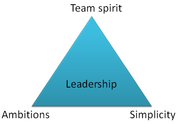Project management within volunteering organisations
(→Important factors within volunteering management) |
(→Team Spirit) |
||
| Line 13: | Line 13: | ||
=== Team Spirit === | === Team Spirit === | ||
| − | It is important that the | + | It is important that the project group see themselves as a team and try to solve their challenges together in stead of separately. The project group has to meet on a regular basis, both in professional (here: scouting) and social context. The meetings has to be carried out in a professional and result-oriented way. It is often an advantage if the project group consists of members with different backgrounds, this being different geographical locations, different educations, different working experience and different scouting experiences. |
=== Ambition === | === Ambition === | ||
Revision as of 17:13, 24 November 2014
Contents |
Leading without classic authority
Within volunteering organizations, leading of projects is being done without the classic authority, as seen in companies. This means that all volunteers have to be motivated by other factors, such as the feeling of purpose or the process of the project. To create a motivational atmosphere it is also important to focus on communication and on involving the volunteers. The Danish scouting and guiding organization, Det Danske Spejderkorps, was drawn upon for references and case examples. The objective of this organization is to create an inspirational environment with possibilities for development of the members.[1] All in all, this article strives to explain some of the learnings about project management that can be drawn from a volunteering organization.
Important factors within volunteering management
A study were done in 2006 on what makes a scout group attractive to be in. A scout group typically consist of 5 branches, each branch spanding between specific ages, e.g. scouts from 6-8 years old or 12-16 years old. For each branch there will be one or more leaders. There will also typically be a group leader, a treasurer and a board. Though the study were done specifically on groups, some of the findings are also true for project groups within scouting. The relevant findings are discussed below.
From the study [2] we know that four factors are especially important for groups of volunteers, these are Team Spirit, Ambition, Simplicity and Leadership.[3] The study has shown that non of these factors can be replaced by the others and that leadership is the adhesive binding the others together.
Team Spirit
It is important that the project group see themselves as a team and try to solve their challenges together in stead of separately. The project group has to meet on a regular basis, both in professional (here: scouting) and social context. The meetings has to be carried out in a professional and result-oriented way. It is often an advantage if the project group consists of members with different backgrounds, this being different geographical locations, different educations, different working experience and different scouting experiences.
Ambition
Simplicity
Leadership
As seen in the figure, leadership is the adhesive, that binds the other factors together.
- Team spirit: The whole group works as one team.
- Ambition: The group has high and visible ambitions.
- Simplicity: The group has organised the work, so it is simple and manageable for the individual leader.
- Leadership: The leadership of the group functions as a rallying point and leads the way. (Has to be solid and visionary.)
Forklar mere om hvad det her går ud på. Skriv mere til hver bullet. Skriv mere til selve billedet.
Skriv eventuelt det om at se sig selv i spejlet eller se ud af vinduet og specielt om mængden af selv-evaluering for alle.
Noget om patruljesystemet der påtænker at få alle med på bussen. Tag eventuelt fat i ledelseskursus 1 og problemet at være villige til at få folk af bussen igen.
Noget om mængden af kommunikation og involvering.
Conclusion
A company culture that focuses on the employees’ development provides value to knowledge based companies, because the employees are the most important resource of the company. Furthermore the resistance to change within the company can be minimized by focusing actively on communication and on involving their employees. This will help the company adapt more to a quickly changing market. Additionally, volunteering organizations provide insights into different motivational factors that drive its members to actively engage in projects, knowledge that can also be used in companies.
